A Brief History of NuTone Intercom Systems
 Thursday, August 9, 2012 at 10:42AM
Thursday, August 9, 2012 at 10:42AM Part 1
In order to understand NuTone intercom system designs you need to understand how the systems fit onto a time line. NuTone system designs were evolutionary, meaning that new models were based on the previous models, but with new features and better technology.
NuTone would design a “platform”, which was the fundamental building block that every model would use. By adding features to the platform, new and different models would be created.
NuTone intercom systems can be divided into different groups based on the type of wire each platform uses. There are two main wire types: 3-wire systems and 6-wire systems. These two wire types comprise about 80% of all NuTone intercom systems.
There are a few exceptions with regard to wire types. NuTone has also made 5-wire, 8-wire and 4-wire systems.
Another design consideration with NuTone intercoms systems is how the wiring is laid out and installed. There are two types of wiring schemes that are used with NuTone intercom systems. They are Home-Run systems and Loop-Wired systems.
Home-Run Systems: In a home-run wiring layout each remote station (entry door, inside and patio) has its own individual cable with the appropriate numbers of wires in the cable (3,4, 5, 6 or 8 wires) and these cables all run directly back to the master station. As an example, if there are 9 remote stations, there will be 9 cables behind the master station. Home-run systems comprise 80% of all NuTone systems.
Loop-Wire Systems: In a looped-wired system, there will be multiple stations on a single cable of wires. As an example, if there are 9 remote stations, these may be grouped onto 3 cables. Cable #1 may have 3 stations, cable #2 may have 4 stations and Cable #3 may have just 2 stations. Behind the master station you will only find the 3 cables. NuTone loop-wired systems use either 6 or 8 wire cable.
One thing to keep in mind is the following rule: NuTone intercom models that were designed to be Looped-Wired systems can be looped-wired or home-run, either layout or a combination of both will work. NuTone intercom models that were designed to be Home-Run systems can only be installed with Home-run wiring, no exceptions.
All of the original NuTone intercom systems were vacuum tube designs, and all vacuum tube models are 3-wire systems with one exception (model 2400, which is a 5-wire, home-run Stereo Music Intercom System).
The first model to use solid-state electronics (transistors and diodes) also used a different wire type. It was the model N2561-2562. This revolutionary model was a huge design step forward for NuTone and was an 8-wire, loop-wired system. The N2561-2562 was in production from 1957 through 1974, that's 17 years!
A quick note about early NuTone model numbers: In the early days, NuTone used model numbers like 2011-2012. The 2011 and 2012 are basically the model except the finish (color) of the model was different. For example, the 2011 had a silver faceplate and the 2012 had a copper-tone faceplate. This is the way NuTone labeled their Intercom models until the mid 1970's. After 1974, NuTone added letters to the model number to denote the finish of the intercom. For example a IMA303T (traditional) was a dark walnut finish, and an IMA303L (light) had a light maple finish.
The last year of production for vacuum tube models was 1966. Since then all models have solid-state electronics.
Vacuum Tube 3-Wire Models:
1954 – 1966: 2011/2012 2013/2014 2015/2016 2053/2054 2055/2056 2057/2058
Vacuum Tube 5-Wire Model:
1957 - 1962: 2400 Stereo Music Intercom
Solid-State 3-Wire Models:
1966 – 1971: 2067/2068
1968 – 1975: 2090/2091 2063/2064
1975 – 1983: IM203/IMA203 IM303/IMA303 IM323/IMA323 IM313/IMA313 + B,C,D
1984 – 1994: IM2003 IM3003/IMA3303 IM3103/IMA3103
1994 – 2006: IM3303/IMA3303
Solid-State 5-Wire Model:
1966 – 1972: 2071 Stereo Music Intercom
Solid-State 8-Wire Model:
1957 – 1974: N2561/N2562 2500
1975 – 1983: I600 SM428
Solid-State 6-Wire Models:
1965 – 1975: 470
1968 – 1975: 2540/2541 2542 462
1975 – 1985: IM406/IMA406 IM806/IMA806
1986 – 1995: IM4006/IMA4006 IM5006
1996 – 2006: IM4404/IMA4406 IM5000
Solid-State 4-Wire Models:
1997 – 2004: IM3204/IMA3204 SR9000 Stereo Music System
Finally we have to include the rarest NuTone Intercom model ever made, the IM6106. Originally the IM6106 was scheduled to be released in 1988 but due to design and manufacturing problems, the release was delayed many times. There were about 400 pre-production units released to dealers and installed in homes. For the next 3 years, everyone struggled to keep these units working until finally the model was dropped and all of the 400 units were replaced at NuTone's expense. If you have an IM6106 you have a rare and unrepairable unit.
 Cindy & Christopher
Cindy & Christopher
Platforms are the starting point:
The very first NuTone intercom systems (the vacuum tube models) were all designed around the same platform and all of these models used the same inside remote, entry door and patio stations. The original idea was that a homeowner would buy a basic model like a 2011 (which only had AM radio) and they could update just the master station to a better model (AM and FM) a few years later.
Of course, this never really happened and the homeowner had to live with just AM radio.
The concept of platforms is still used today. The advantage of using platforms is that it keeps design time and manufacturing costs lower. The disadvantage is that when a new platform is designed it will not be backwards compatible with older models. This means that when a system is updated to a new platform, all of the equipment must be replaced also.
Updating platform designs is necessary. Without new platforms there would never be any new features and we would all still be listening to AM radio.
The additional advantage to platforms occurs when servicing and repairing NuTone intercoms systems. Common problems will occur across the platform to all models.
There are a few unique models that do not share their platform with any other model. These models inlcude the IM806/IMA806 and the 2500 Stereo Music Intercom, I600 Selective Call Intercom. These “specialty” models are typically more expensive and more difficult to repair.
Finally a note about NuTone model numbering. Starting in the mid 1970's, NuTone began to use model numbers which started with the letters “IM” which mean “Intercom Master”. When NuTone would release a mid-production update to an existing model, they would add a letter to the “IM”. So the IM313 would become the IMA313, of course some models had many updates and the IMA313 became the IMB313, then the “IMC” and finally the “IMD”.
While there are many similarities between original versions and updated versions of any given model they are never exactly the same. You MUST determine the exact version and use the correct manual to have any chance of repairing your intercom.
 Cindy & Christopher
Cindy & Christopher
Now that you have some back ground about NuTone intercom systems, lets get back to the 10 most common things that go wrong.
In general, many problems with NuTone intercom systems can be solved with some basic adjustments and general service. Common things we hear from homeowners about their intercom systems are:
-
“We had one of those NuTone intercom systems in our house and it seems to work well for a while then it didn't work right any more”.
-
“I used to be able to hear my door bell through the intercom system and now I can't”.
These types of comments, taken on their face value, would seem to indicate a broken or damaged system when, in reality, they are caused by having a system that is way out of adjustment.
While every model of NuTone intercom system has it own individual setup parameters, there are some basic adjustments that will help your system operate at its best.
How to adjust your intercom system:
On every NuTone Master Station there are 2 primary adjustments:
-
Intercom Volume: This adjustment varies the volume of the voice (intercom) part of the system.
-
System Volume: This adjustment varies the music volume throughout the entire system at one time.
While these adjustments are called “volume” controls which is easy for consumers to relate to, they are not truly volume controls. These are actually “gain” adjustments.
Here's how gain adjustments work: Intercom systems use amplifiers to boost up every signal (music, radio, voice) that is sent to them. When you speak into an intercom station, your voice becomes the signal and the amplifier boosts it up and sends it out to the other stations where the recipient can hear it.
The gain adjustment changes how much of the signal from your voice is sent into the amplifier. At a maximum setting (100%) the amplifier receives all of your voice and the sound from the remote stations will be very, very loud. If you lower the “gain” adjustment to 25%, the amplifier receives less signal and the final volume will be much lower.
You can look at gain adjustments as a “power control”; the more signal there is, the louder the volume, and the lower the signal, the lower the volume.
How is this important to your intercom system? If you have the gain controls set too high, the amplifier will produce too much volume throughout your house. In response to the very loud volume, you will do what seems natural and turn down the volume knob on each remote station. This is exactly the wrong thing to do. Each remote station has its own individual volume control, which is referred to as a “local volume control”. Local volume controls change the volume at their own location and do not effect any other part of the system.
By turning down a local volume control, you will lower the volume at that station, but you are not lowering the power output of the amplifier. If the gain adjustment is set too high (90%), and the local volume controls are turned down (10%), there is excess power leftover from the amplifier in the system.
Contrary to what many people may think, the excess power does not evaporate into thin-air. It has to go somewhere and it becomes heat in the amplifier. Any time you have the words “heat” and “amplifier” in the same sentence something is destined to go wrong.
Here's the correct way to adjust your intercom system to have it work as well as it possibly can:
-
Turn each volume control on every remote station to maximum.
-
Turn the “Intercom Volume” and “System Volume” on your master station to minimum (fully counter clockwise).
-
Turn on the radio and tune it to a strong FM station
-
Turn up the “System Volume” (clockwise) until the radio plays at a comfortable level.
-
Turn up the “Intercom Volume” adjustment half-way.
-
Place someone at the furthest remote station, and call to them by using the intercom system.
-
Make small adjustments to the “Intercom Volume” until the conversation through the system is clear and has enough volume without being loud.
Your system is now basically in adjustment. You will find that the music volume throughout your house is comfortable and the intercom calls are clear and easy to understand.
You will also find that if the music volume is slightly loud in some rooms, you can make small volume adjustments in those rooms by turning down that local volume control. A small change, say from 5 o'clock to 3 o'clock on the volume knob will make a substantial change in volume in that room without adversely affecting the intercom clarity.
These adjustments will also allow you to hear your intercom system's built-in door chime loudly and clearly, if your system has that option.
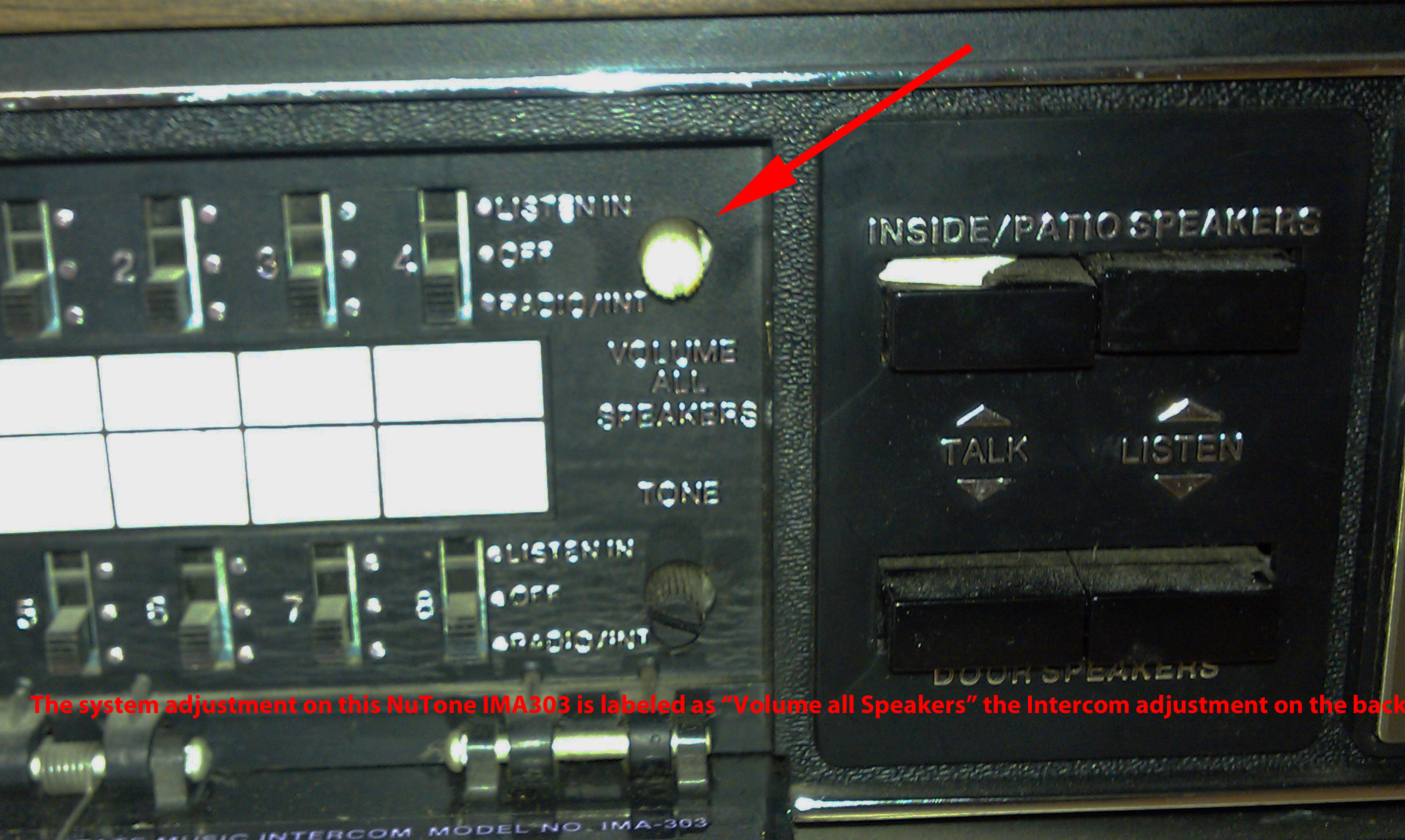
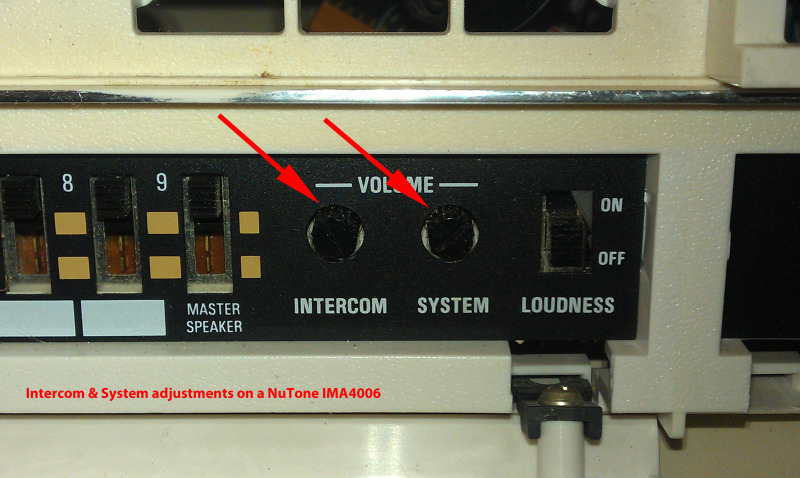
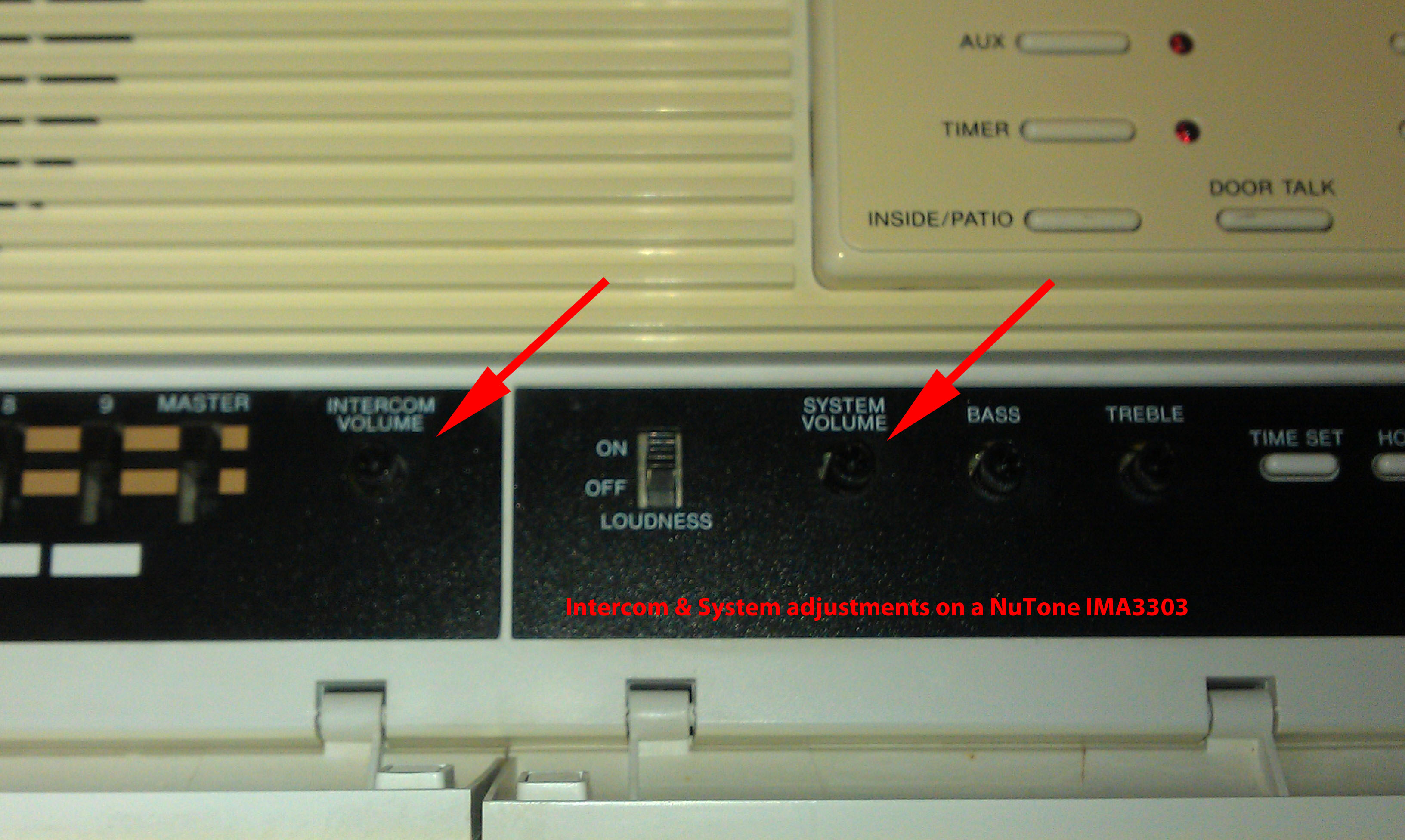
 Cindy & Christopher
Cindy & Christopher
Now that you have your system properly adjusted, let's look at another common problem that will make it seem that your system is broken.
Dirty volume controls on the remote stations will give the impression that you have stations that do not work correctly or at all.
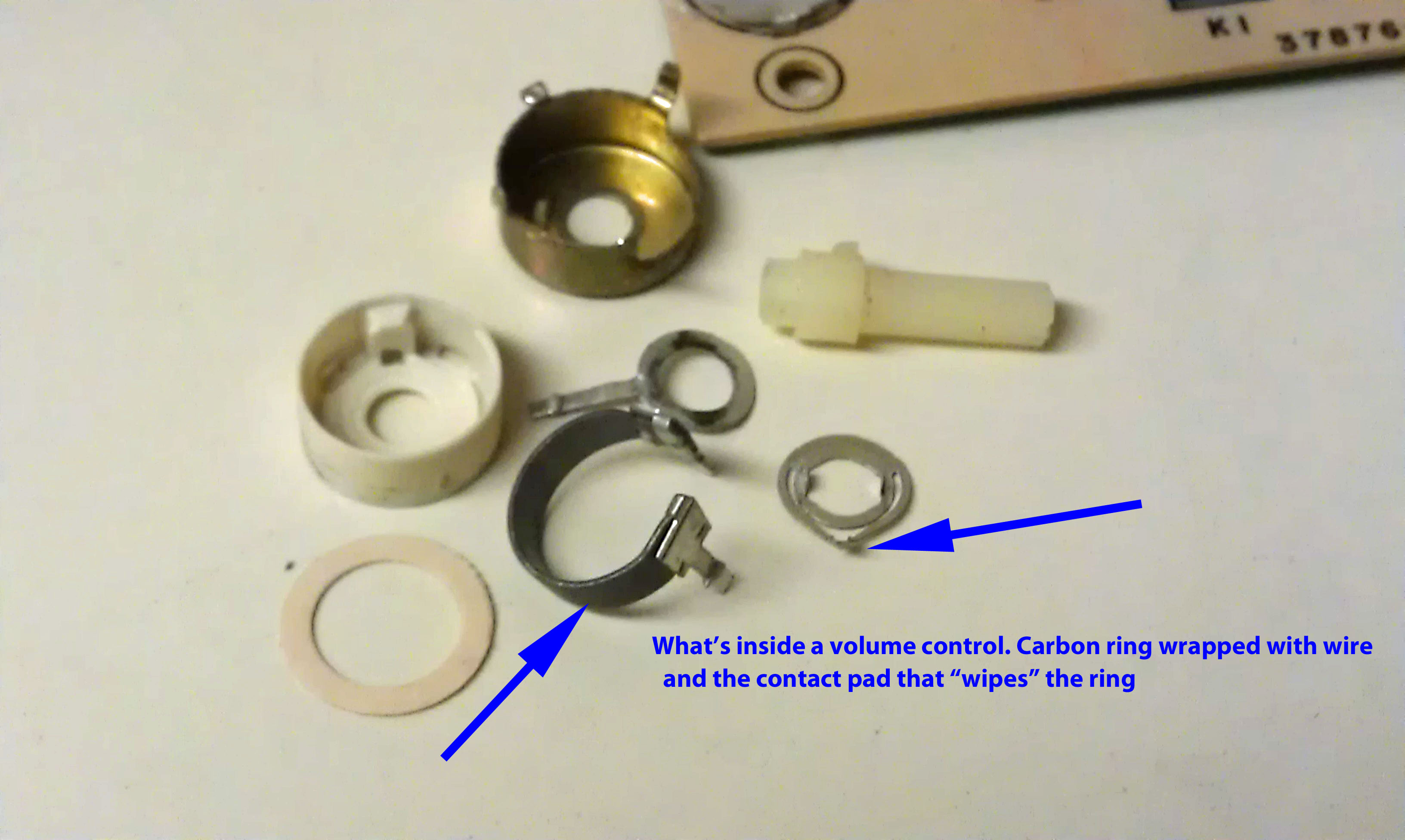
It's important to understand why the volume controls get dirty and how this effects the operation of your system. The volume knob is connected to the volume potentiometer, which is constructed with a ring of carbon (like a donut make from pencil lead) which has a very small wire (the size of a single strand of hair) wrapped around and around the carbon ring. Touching the wire-wrapped carbon ring is a small metal pad which touches the wire and it moves around the ring as you turn the volume knob.
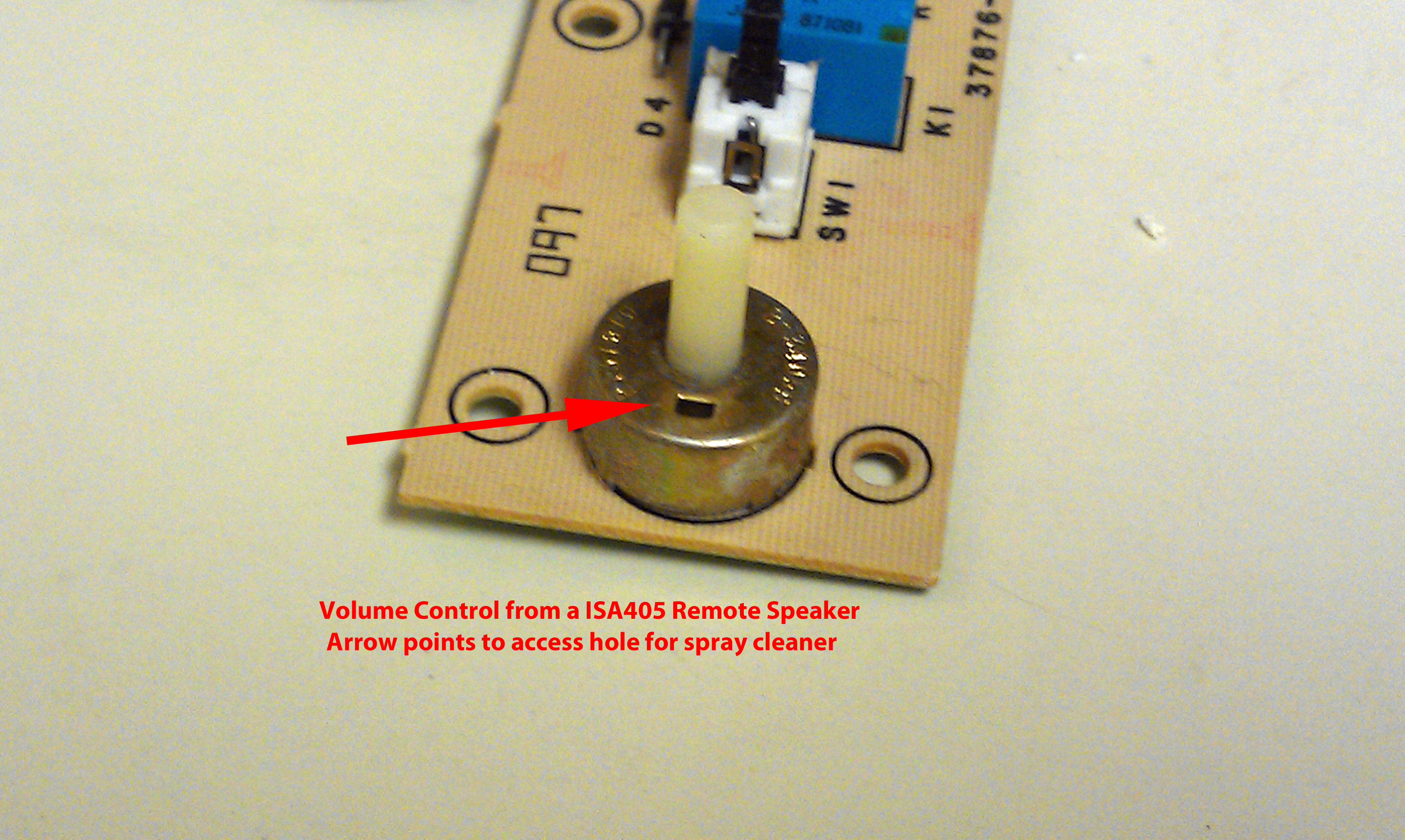
All of this assembly is enclosed inside a metal case, which has holes in it. Over the years, dirt, dust and sheet rock particles filter down the inside of the wall cavity and get into the inside of the volume control.
The dirt and dust builds up a layer over the small wire that wraps the carbon ring. Dirt and dust is an insulator (electricity doesn't go through it). When you turn the volume knob form where it has been set to for the last 12 years, you are moving the metal pad from its clean spot over to a dirty spot.
Since the dirt and dust is an insulator, the pad looses its connection and the sound from the station stops.
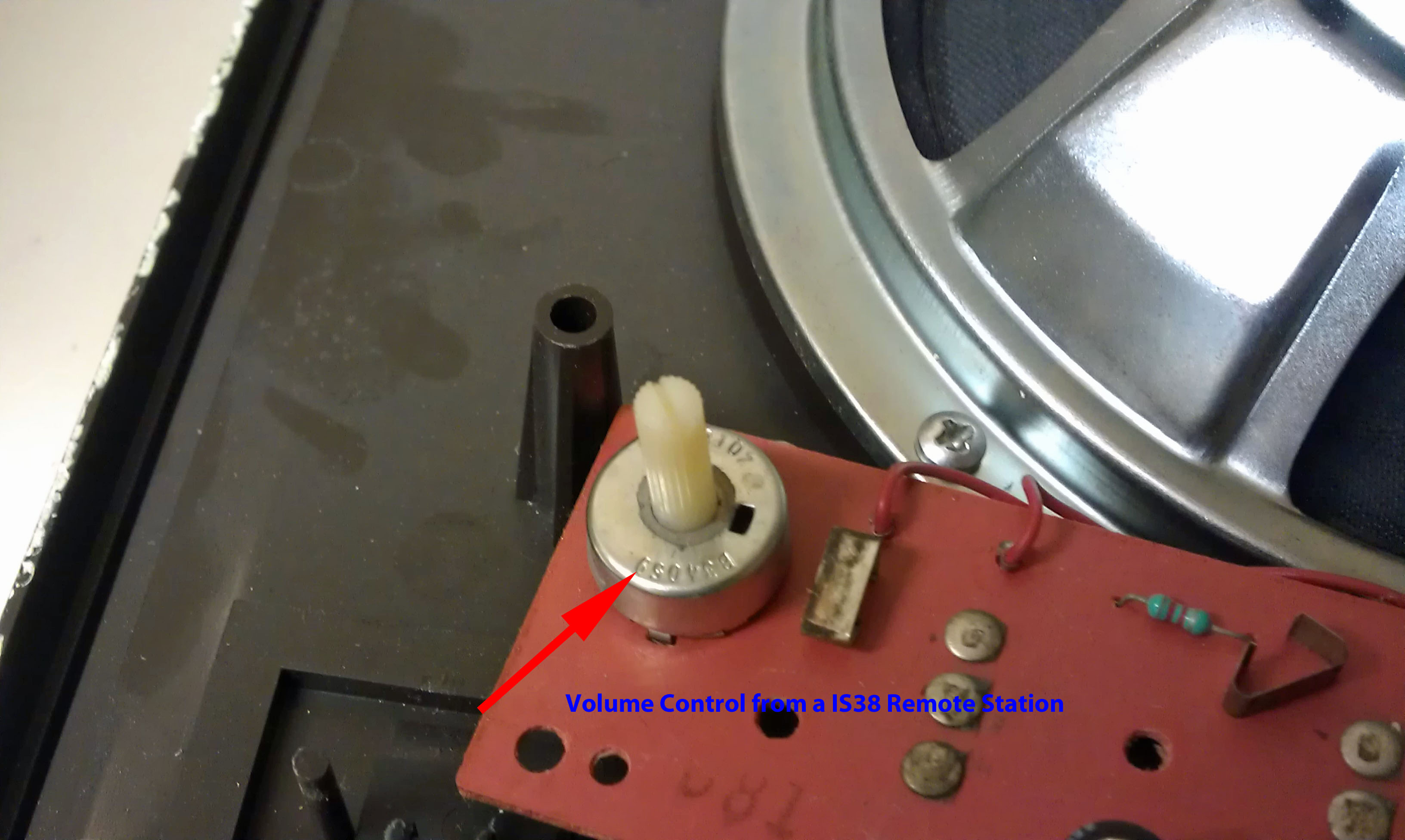
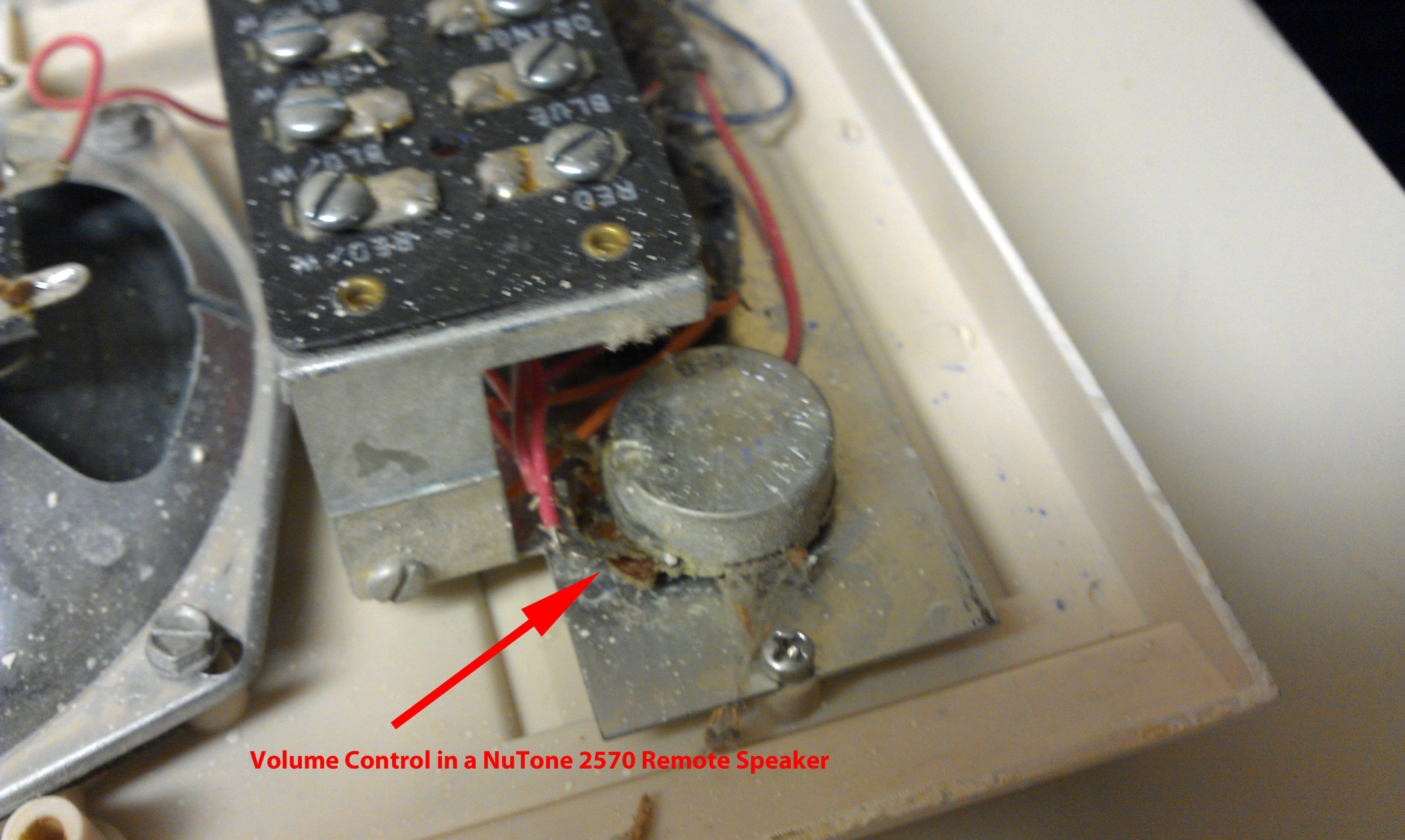
The way NuTone volume controls are designed allows this problem to be corrected by simply turning the volume knob back and forth many times to clean away the dirt and dust. This will solve many intermittent volume related problems.
Sometimes when the volume control is very dirty it will need to be cleaned. You MUST NOT use WD40, carburetor cleaner, TV tuner cleaner, silicon spray or any type of electrical contact cleaner. All of these are the wrong type of cleaners and can shorten the overall life on the volume control or just ruin it. These are all basically solvents which will quickly evaporate and leave the control worse than when you started.

Over the years I have used many different brands of cleaners and I have settled on two products made by the Caig Company. I use DeoxIT D5 to clean the control and I follow it up with DeoxIT Fader F5 to help restore the smoothness of the control.
Cleaning volume controls is a task where less is definitely more. You do not need to “flood” the control with cleaner. The smallest amount sprayed into one of the openings in the case, followed by vigorously turning the volume knob fully back and forth will usually do the job. A second application can always be done if needed.
Why is less more? When the volume control was manufactured it had a small amount of DI-electric jelly (looks like Vaseline) placed inside the control to help prevent corrosion of the small wire-wrapped carbon donut, and to give the control a smooth feel as you turn the knob. Flooding the control with cleaner will wash away the Di-electric and the control will have a rough feel as you turn it and it will corrode more quickly.
After the application of the DeoxIT D5, cleaner a small spray of the Fader F5 will help restore the feel of the control when you turn it. Again, less is more. Just the smallest amount is needed.
This type of cleaning is only typically needed every 8-10 years, more than that has the same effect as using to much cleaner. If you notice that the control becomes a little “scratchy” sounding later on, just turn the control fully back and forth to wipe away the dust and it should be fine.
Now that we have cleaned the volume controls, let's take a look at the intercom control switches on the remote stations.
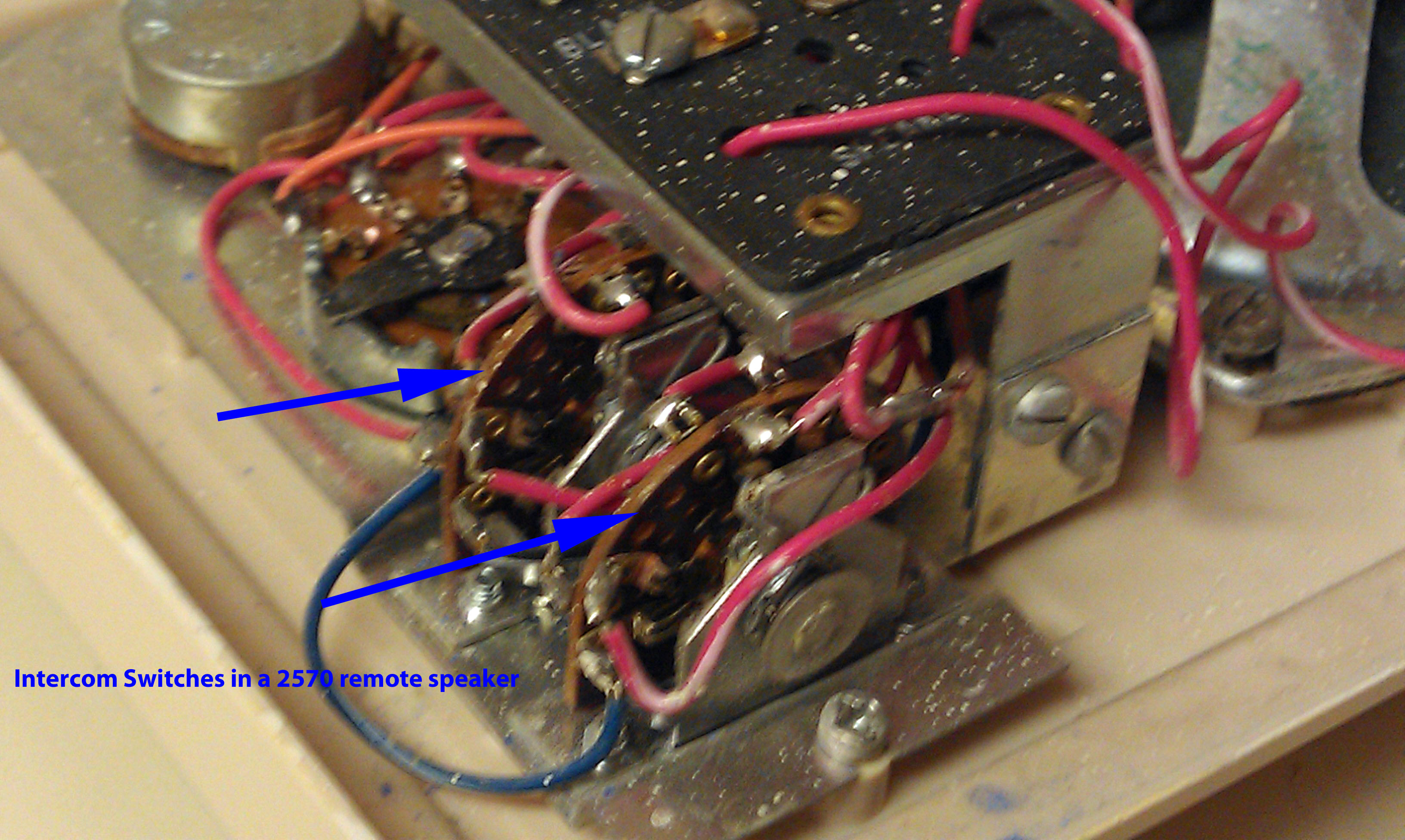
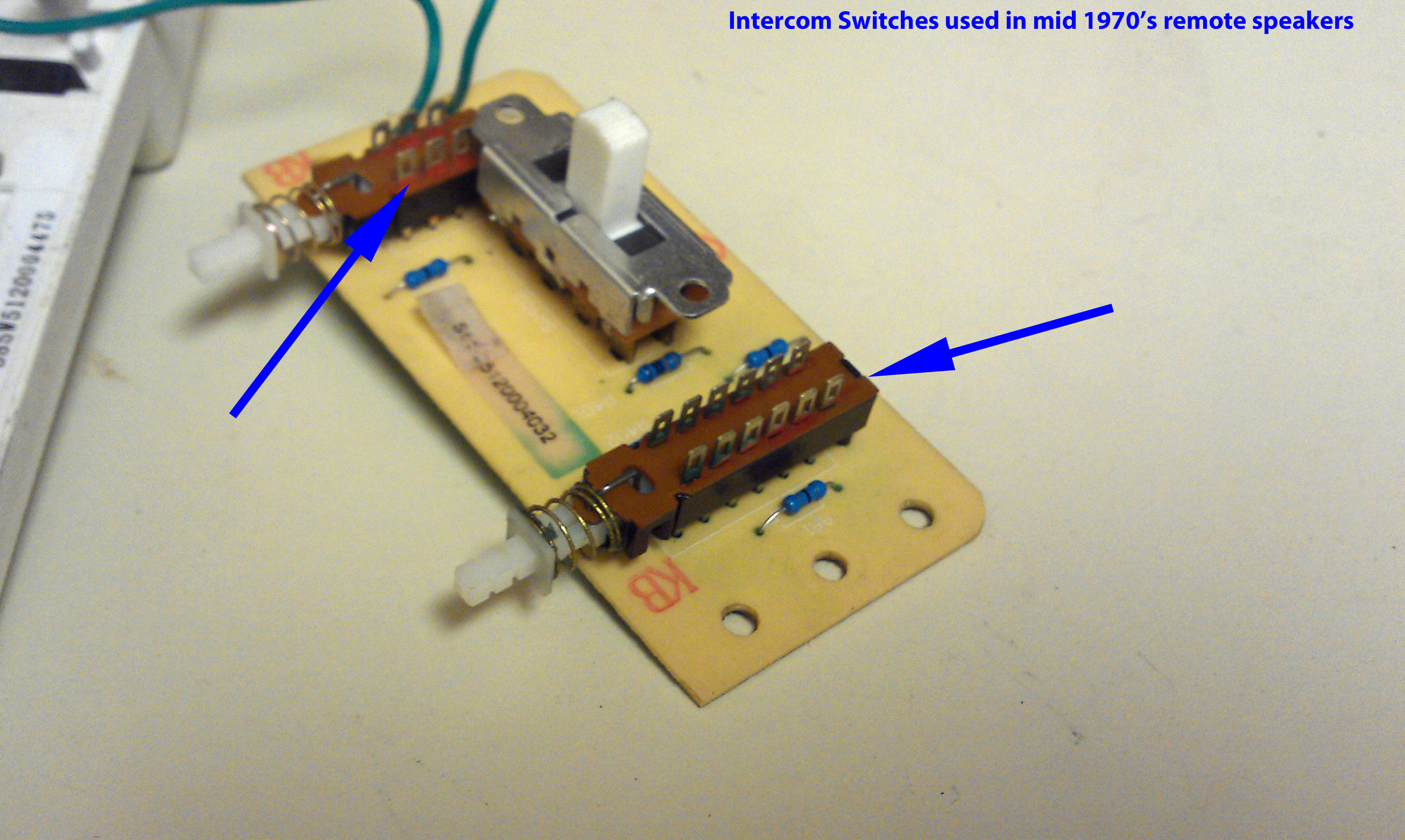
NuTone has used many different types of switches on remote stations over the past 40 years. Even though they differ in design, they all share a common problem. Just like the volume controls, dirt and dust, and especially sheet rock dust, cause many problems with these switches.
The typical symptom of dirty and worn control switches is a loud “scratchy” noise that you hear through the intercom system when a switch is operated.

This noise is caused by the contact surface of the switch being scratched by the dirt and dust that gets inside the switch over the years. When the switch was new, the metal surfaces inside the switch were clean and polished and ultra-smooth. When you operated the switch, the metal surfaces could slide across each other easily and everything was perfect.
Over the years dirt and sheet rock dust get inside the switch and coat the metal surfaces. When you operate the switch, the metal surfaces slide across each other along with the dirt, and the dirt scratches the metal surface.
Now the metal surface is scratched. When the switch is operated, instead of clean, polished surfaces sliding past each other, it's more like rubbing 2 pieces of sand paper together. The surfaces are rough (on a microscopic level) and the “scratchy” noise you hear is the electricity moving across the rough surface.

While there isn't a permanent solution for scratchy switches (short of replacing the switch with a new part) cleaning the switch will help a lot. You can use the same cleaners as the volume controls. Simply spray the switch with just a little D5 and work the switch until it improves. You may need to use several applications because getting the cleaner inside the switch can be more difficult than the volume controls.
I have cleaned systems that were basically unusable due to dirty volume controls and switches and often these system can be restored to 70%-80% of new with some careful cleaning.
Cleaning outdoor Patio stations is the same as cleaning inside stations, except Patio stations are often in much worse condition. Having been outside in the weather takes a real toll on equipment and even the best cleaning job will not always restore a Patio station.
 Cindy & Christopher
Cindy & Christopher
OUTDOOR STATIONS: ENTRY DOOR & PATIO STATIONS
Now that you have your system adjusted correctly, and you have cleaned all of the volume controls and intercom push buttons, it's time to take a look at the condition of your outdoor speakers.
Outdoor NuTone speakers are located at an entry door or on a patio or deck. Entry door speakers will either be just a grill with a speaker located behind the grill, or it may also have a door bell pushbutton on the grill.
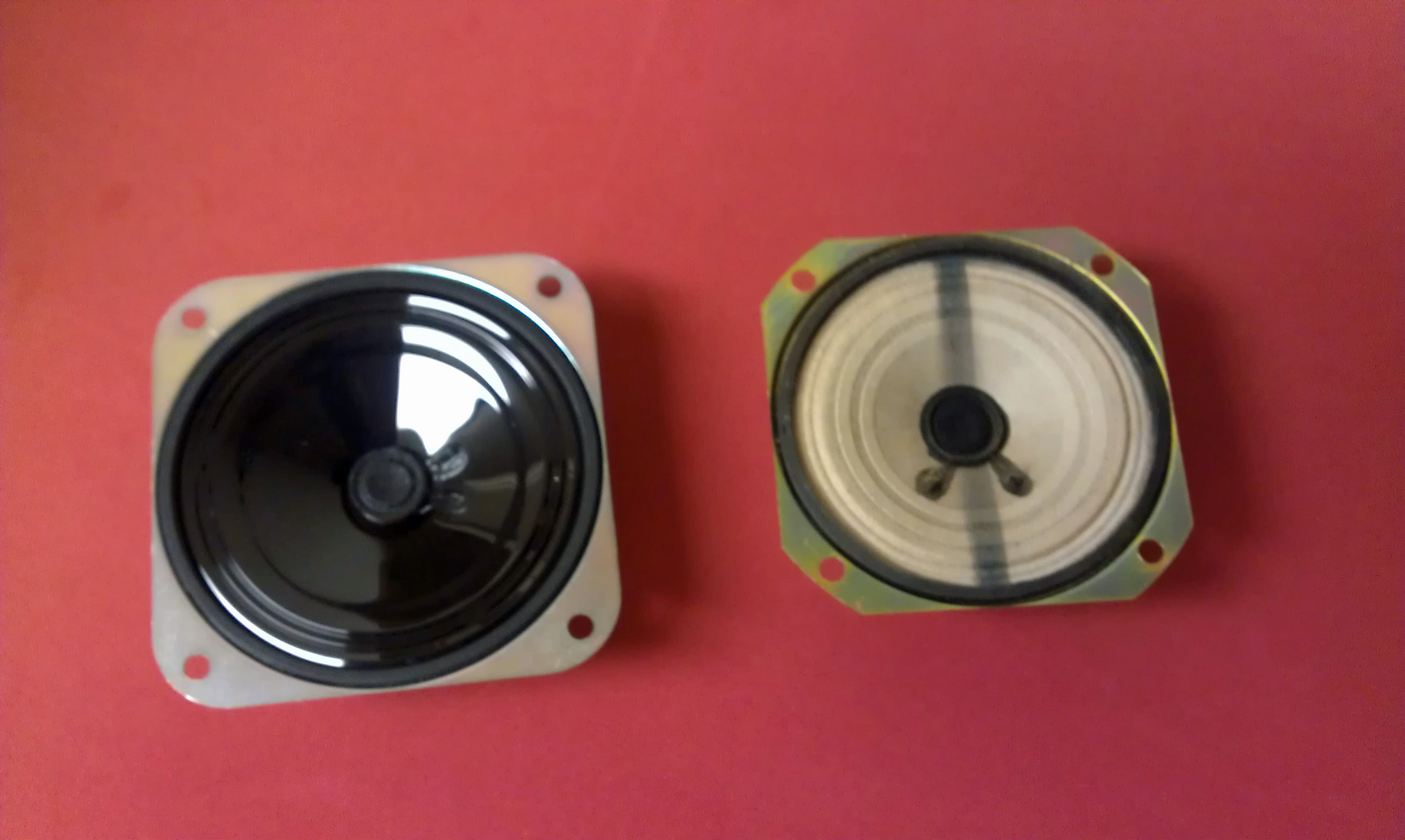
Older NuTone entry door speakers used to have paper speaker cones inside a metal frame. Over the years, the paper would rot away from the sun and rain and sometimes little insects would eat the paper. Starting in the late 1980's, the paper cones were changed to plastic, which improved their longevity.
Even with plastic cones the speaker can still fail. Replacing door speaker cones is easy. They are all 3-1/2” square 16 ohm speakers and are commonly available from any NuTone Service Center. All you have to do is remove the grill from the wall housing, turn it over, remove the 2 wires from the speaker terminals, and remove the 2 or 4 screws that hold the speaker to the back of the grill. Reassemble in reverse order, and you're done.
Patio stations come in several different configurations. The earliest patio stations were all 2 piece designs. On the outside wall there will be a small recessed panel which has both the volume control and intercom pushbuttons on it. Higher up on the same wall will be a large 12” x 12” aluminum grill with a speaker cone behind it.
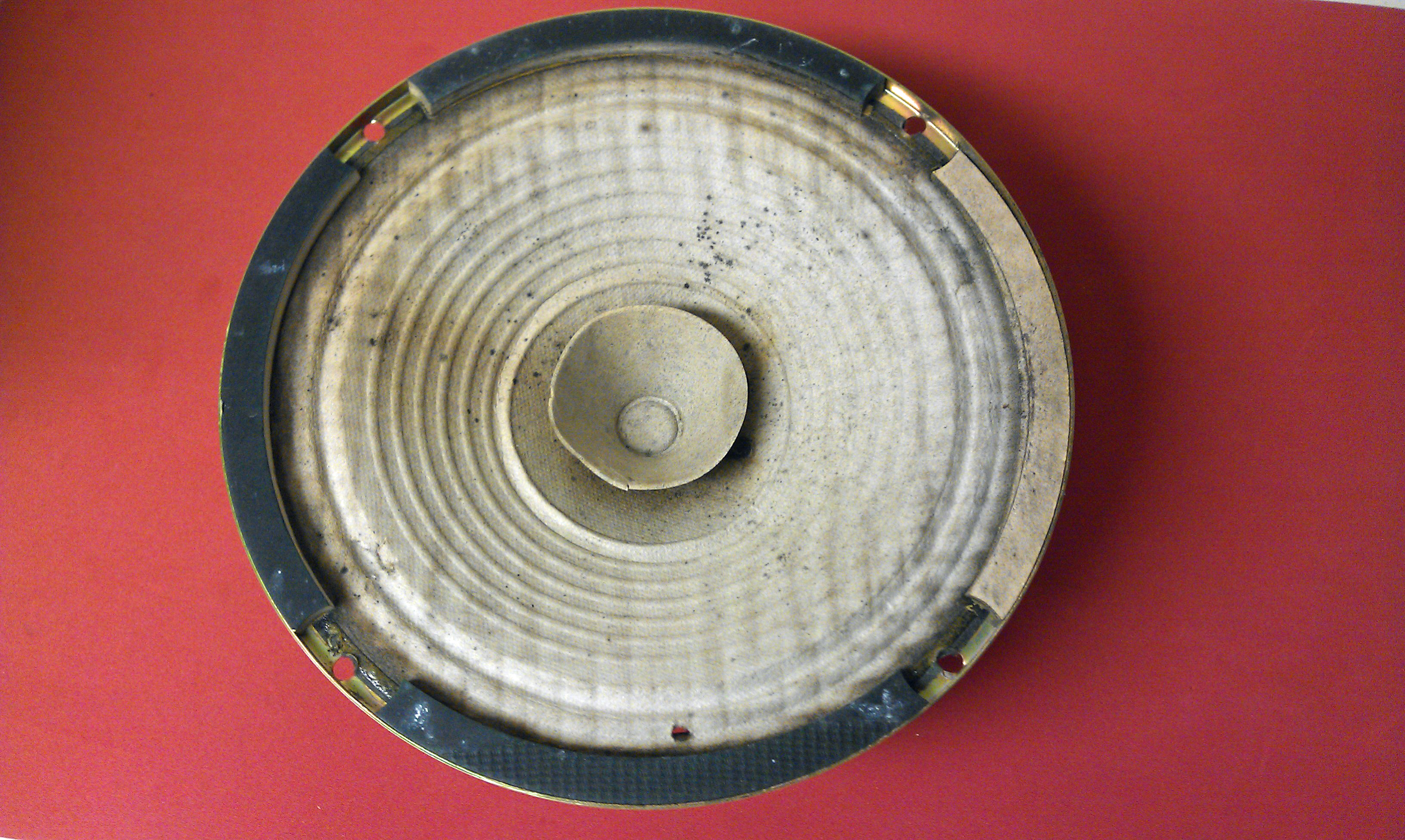
The speaker cone behind the grill will be either a paper-coned speaker or it might be made from a piece of flat Styrofoam. These were call Poly Planar speakers and they last almost forever. All of these cones are 8” diameter.
Starting in the 1970's, a smaller one piece patio station was introduced. It is usually an outdoor version of the same size station from inside the house. These use 5” diameter speaker cones.
Let's look at NuTone speaker cones throughout their history. Speaker cones have a rating in Ohms. This is the impedance of the speaker and it is important. The original NuTone speakers cones were 3.2 ohms, then systems changed and used 45 ohm speakers, then systems changed again and speakers became 25 ohms. You may notice that none of these ratings are 4 or 8 ohms, which are used in home stereo systems.
It is important to have the correct impedance speaker for your system. If you use the wrong speaker it can make you system operate incorrectly, or even cause the master station amplifier to fail.
Replacing speaker cones is easy and will restore your system to full operation. If you have a multi-meter, you can check the impedance of the speaker cone by first removing the wires that are connected to the speaker, and then connect the meter to the terminals. The reading should match the rating stamped on the speaker magnet. If you get a reading of 0 or infinity, the speaker cone has failed.
 Use this Button to find out about Replacement Patio Speaker Cones
Use this Button to find out about Replacement Patio Speaker Cones
Basic Troubleshooting & Wire Types
A common problem with many NuTone intercom systems is that 1 or 2 of the stations on a system will not work correctly. Maybe the volume is low or the intercom functions don't work properly. This may be a problem with the station itself or it can be a problem with the wiring.
A simple way to determine what is causing the problem is to swap the troublesome station with another station in the house that works correctly. If the problem follows the suspect speaker, then the speaker is the problem. If the problem remains in the original location, the it might be a wiring problem.
When swapping speakers around, you must take notice of how the wiring is connected. You may have 3, 4, 5, 6 or 8 wires connected to the back of the speaker. NuTone Intercom systems were designed to be easy to install, even by the do-it-your-selfer. All of the wire connections will be labeled either by the color of the wire, or in the case of 3-wire systems, by the actual metal inside the insulation.
On 3-wire systems, the cable is a flat, gray 3-conductor ribbon wire. Inside the insulation you will find that the wires themselves are different colors. #1 is silver (this is used to index the side of the wire you start from), #3 is copper, and that only leaves the center wire (which is also copper, but it's in the center of the cable).
If you look at the back of any early 3-wire station, you will find molded into the plastic “Silver”, “Center”, “Copper” and arrows that point to the screws where the wires connect.

Later, NuTone added a red stripe to wire #1 (silver) and a blue stripe to wire #3 (copper) to make it easier. You will find stations labeled as “red/silver”, “Center” and “Blue/Copper” on stations from then on.

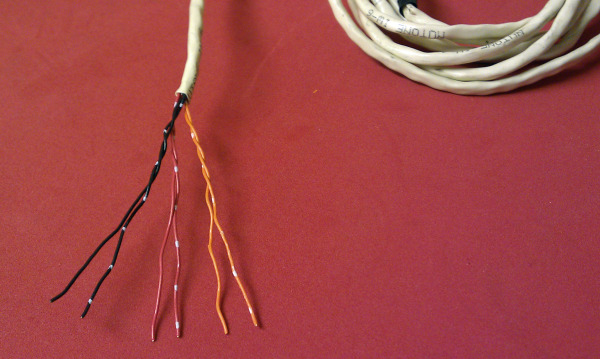
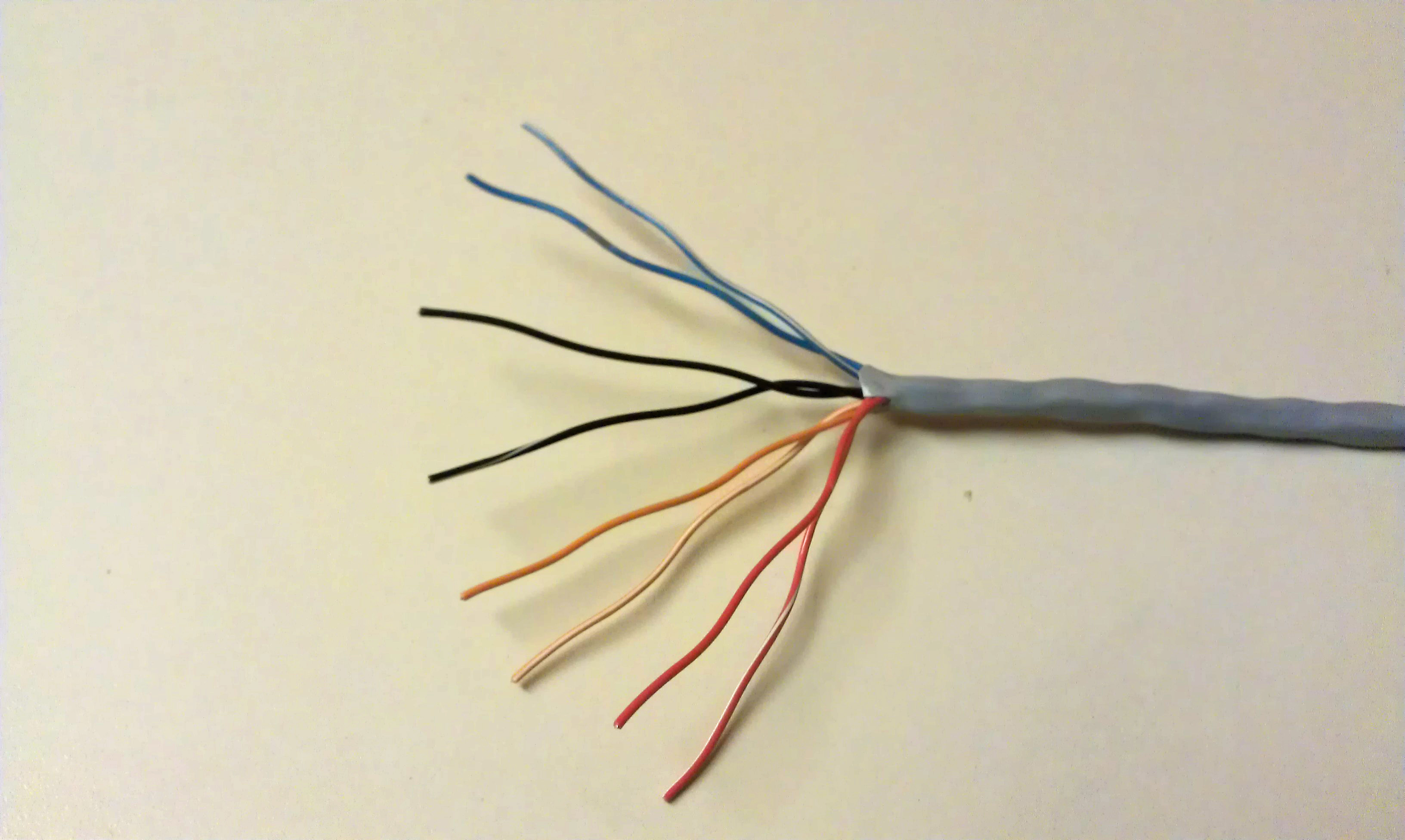
On 6 and 8-wire systems, you will have 3 or 4 twisted-pairs of wires. These twisted-pairs will be colored Red – Black – Orange – Blue (blue is only in 8-wire cable). If you look at the pairs carefully, you will see that in each pair, 1 wire will be a solid color and the other will have a white stripe. This is how the wire is indexed for proper polarity.
When you look at the connections on the back of a 6 or 8 wire speaker station, you will see that the screw terminals are labeled “Red/Red White”, “Black/Black White” and so forth.
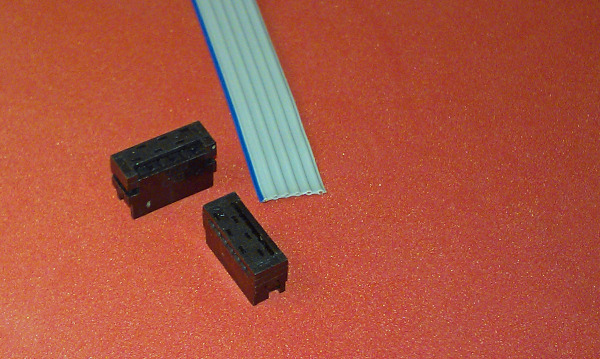
The exception to this is a special type of wire that NuTone used from 1986 through 1992. It is a special type of 6-wire cable designated IW6R. IW6R is a flat 6-conductor ribbon cable used on the original IM4006 system.
The idea behind this ribbon cable was the it used special crimp-on connectors which terminated the cable and plugged on to the matching connector on the speaker board.
This design was a great failure. The original IW6R ribbon wire had solid wire in the cable and it often failed to make a proper connection in the crimp-on connector. Later the wire in the cable was changed to stranded wire, which helped the termination problem to some degree but it did not solve the problem completely. The primary issue, after the wire design was resolved was that installer would not read the instructions on how to terminate the wire, and if it was done incorrectly, the connection would not hold up.
I must have completed hundreds and hundreds of warranty calls which just involved changing out all of the crimp-on connectors.
IW6R cable has a blue stripe on one edge, as an index to identify the wire strands inside the ribbon. Starting on the edge with the blue stripe the color order is: “Red/White”, “Red”, “Orange/White”, “Black/White”, “Black” and “Orange”.
It is important to keep this order consistent throughout any installation when you are reusing IW6R cable and installing new equipment.
Reader Comments (105)
Chris,
Thanks for the guidance. I really only expected T9 would be bad if it was a common defect found in the field over the years. Based on your statement that you've never replaced one, I changed my approach. I fed 1KHz from the collector of T10 and compared it to a direct connection to the speaker and T9 certainly looked good- I should have done that instead of bothering you.
I hope I caught you before you desoldered one to check the primary reading.
Anyway, it was C53. The master station appears good on the bench. I'll install it to test in the house, then I plan to modify it; remove the cassette and affix a Sirius receiver and ipod base. The power transformer (T10) is also blown, I've been testing with a bench DC supply, so that's next.
Again, thanks for your website, this would have been 10 times more difficult without the service manual. I'll put an entry in your guestbook after I get this system reinstalled and completed.
A Thousand Thanks,
Ed
Hi Ed,
I'm glad that you found the source of the problem, a full recap is usually in order for these models.
The can capacitor should be restuffed and opposed to replacing it with individual components.
Chris
Chris-
We have a home built in 1992 that has a working IM-4006. We had the same model at our last house and I replaced it with a IM-4406 unit in order to get a CD player and more modern appearance. I'd like to do the same in this house, but Nutone no longer makes the 4406. The replace kit they do offer through Home Depot is way too expensive (I have 12 satellite speakers and 2 door units). Any idea where I can pick up a working IM-4406?
Mark
Hi Mark,
If you're looking for a 4406, you would want to look for an IMA4406 (not a M4406). You will also need a IR105 Rough-in kit and since you have 12 remote stations you will need a IAA440 Expansion Kit.
Finding all of these items will be a lengthy project since all of them are discontinued items.
I will caution you about buying a used Master Station from a private seller. The IMA4406 are not without their own specific problems and many of them will need some repair (perhaps sooner than later). The biggest risk are Master Stations that may have Micro-Controller problems, these units can be very expensive to repair (if repair is even possible),
As for Masters that are being sold as NOS - beware and make sure that the units can be returned if they do not work. Many of these so-called NOS units are actually units that were defective when they were new out of the box and after they were replaced under warranty by NuTone, the defective units were never returned.
If you're buying a "refurbished" unit, you need to ask exactly what was done to refurbish it. If the Power Module was not rebuilt for the common failure issues, then the unit will likely not be reliable into the future. A "refurbished" Master should have at least a 1 year warranty against any problems, including the CD Player.
Finding a IR105 is not to difficult, they seem to be around if you look. Finding a IAA440 Expansion Kit may be difficult because it was not an item that most dealers kept in stock, so there are less of them left over today.
Thanks
Chris
Is Airking a brand or model of intercom. It is in a 1963 house. It has separate music speakers and intercom speakers. The main unit will not power on.
Will a nutone N2561b retrofit an n2651/2.
Hi Dennis,
All Model N2561 & N2562 are interchangeable. The N2561 "B" you asked about is just a common way of referring to the Master Station itself.
The Wall Housing was packaged in the "A" carton and the Master Station was packaged in the "B" carton when the equipment was new and in production.
Thanks
Chris
Hi CeORY,
Yes, there was a company called Berns AirKing and they made a few models of Radio Intercom systems. I've never seen one in person and I don't know much about them.
Thanks
Chris
Dear Chris:
I got a few more questions regarding the long lasting 2560 series:
1.- How does the 2575 Clock Speaker mutes the music ? How does it silence the music throughout the system ? Does it turn the entire system to Stand-By Mode ?
When the alarm is "set", the radio mutes without affecting full-time use of Intercom, however, does it affect the Electronic Chime sound throughout the speakers ? The electronic chime can be heard throughout the speakers only on Radio/Intercom Mode, it does not play on Stand-By Mode nor Monitor Mode. So, when the speakers are on Radio/Intercom Mode, will the Chime play on them when the alarm is "set" on the 2575 Clock Speaker ?
2.- Chassis A to D are heavier, made of germanium based transistors. Chassis E to L are lighter, made of silicon based transistors. Does it affect the sound quality ? Is it true that germanium transistors bring a "finest" vintage sound that is difficult to obtain nowadays ?
3.- The long-lasting 2560 series permits at least 16 speakers. Does it make a difference whether all these are 8 inch speakers or 5 inch speakers ? Do larger speakers consume more power than smaller ones ? The more quantity of 8 inch speakers installed will cause a decrease of the System Volume of the Master Station N2561/62 ?
4.- "Built-In" speakers are the best speakers because the walls act as an "infinite baffle" bringing the highest fidelity sound. The 2576 Outside Surface Mounted 8 inch Speaker is exactly the same as an ISA-77 with a 45 ohms speaker cone. The 2574 Surface Mounted Horn Speaker is a 5 inch Speaker with a horn attachment that amplifies the sound, the horn would act as a baffle too, I guess ?. I think that the 2576 (or ISA-77) doesn't have a baffle. Does this make the 2576 (or ISA-77) a lower quality speaker ? Which sounds better, 2574 or 2576 (ISA-77) ?
5.- The 2560 series is an 8 wire system. The black and black/white wires are the ones that manage the outside (door) communication. My patio speakers are out of reach and located about 20 feet away from their remote controls. That's why I find completely useless to connect the black wires on their remote controls. Everything seems to be alright with the black wires disconnected on them. Is this OK to do ?
Thank-you very much.
Hi Louis,
1. There is no technical information about the Model 2575 Alarm Clock Station and I cannot find a schematic of the station itself, so I have no detailed information about how it actually works. I do not have a 2575 here, so I have no answers for you about it.
2. Whether Germanium or Silicon transistors produce "better" sound quality is a matter of personal preference and belief.
3. The maximum number of remote stations on a 2561 System is 16. An 8" speaker cone will require more current because it is working harder to move a greater volume of air. Since the 2561 was designed to accommodate this number of stations, it is unlikely that there would be any noticeable decrease in volume
4. Since I have no way to test these speakers side-by-side, I have no idea which 'sounds better". The notion that some speakers use in the 2561 system are "higher" or "lower" quality is splitting hairs.
5. I see no reason to leave any wires disconnected anywhere in an installation.
Thanks
Chris
Hi Chris:
Thank-you very much for your guidance.
1. Since we don't have information about the 2575 of the 2560 series, the closest model that might operate the same way is the Clock Timer of the magnificent ultra-rare Nutone 2542. Please, any info that you know about how the 2542 clock silences the music and whether or not the Electronic Chime operates on the speakers when the alarm is "set", would help me solve the mystery of the 2575 since the mechanism and operation probably might be the same.
2. Thanks for your response.
3. Thank-you very much !
4. Well, in my experience I can tell you that the best speakers are the early 8 inch "built-in", that is the 2572, 2573 and the Master 2561 9x6 inch, then in second place the early 5 inch "built-in" speakers: 2570, then in third place the 2574 Horn Speaker and in last place the later 5 inch speakers made in Mexico. In my opinion, "built-in" speakers sound better than surface mounted.
5. Thanks.
Thanks indeed !
Hi Louis,
I have already looked through the 2542 Manual, there's no specific information or schematic for how the clock control works
Thanks
Chris
I have a Nutone IM-203 system in the house I purchased and need to replace the master unit. Would the Nutone IM-3103 Be a compatible replacement? I see they are both 3 wire systems> Thanks.
John
Hi John,
No, the IM3103 is not a suitable replacement for your IM203.
Your remote stations are designed to work only with a IM203 or IMA203.
If you installed a IM3103, you would have to replace all of your remote stations with IS305 inside remotes, IS309 Patio remotes and the door speaker with a IS67
What is wrong with your IM203?
Please let me know
Thanks
Chris
Dear Chris:
1.- A part of my home intercom wiring is unfortunately a kind of "Thermostat cable". This cable does not reach my 2570-B speaker located on my kitchen. So, I "extended" this cable using "choc blocks" joining it to an original 8-wire Nutone cable. Is this Okay to do ? I tried the smallest choc blocks I could find. This incomplete Thermostat cable has always brought me issues. Before using "choc blocks", I tried extending it with "electrical tape" but after a year of clean sound I started to listen interference and noises so I changed to choc blocks. Should I connect it with "choc blocks" or electrical tape ? What is the best way to do this connection ?
2.- Nutone says: "Up to 5 speakers may be jumpered together". This is not clear to me. Does this mean that no more than 5 speakers may be connected from each cable that connects to the 2561 Master Station ? Or just do not connect more than 5 speakers to any satellite speaker ? My wiring diagram is kinda weird. Only one 8 wire cable is connected to the 2561, but it connects directly to a 2570 (1 speaker) located 60 foot away which splits in 5: one for the kitchen (4 speakers), one for the dining room (2 speakers), one for the bedrooms (2 speakers), one for the patio (3 speakers). I want to add 2 more speakers to the kitchen section but it would be 6 (or 7 if you count the 2570), maybe should I add these two using the cable from the bedroom section instead ?
Thank-you.
Hi Louis,
Answer to question #1: I prefer soldering wires together over mechanical connectors. I would simply twist each wire together, solder the joint and cover it a small low-voltage wire crimp connector. After you have soldered and covered all of the splices, fold all of the splices back onto the cable and use electrical tape to cover over the bunch of wires.
Answer to question #2: First you have to be careful when using the Term "Speaker" and "Remote Station" interchangeably. The 2561 was designed to allow loop-wired or "daisy-chained" Remote Stations. The limitation is no more than 5 Remote Stations per cable run. If 1 or more of the Remote Stations on the cable are Wall Mounted Remote Controls (without a built-in speaker) it is allowed to have 1 Speaker connected the this type of Wall Remote Control.
I cannot tell from your description how many complete Remote Stations you have and how many Remote Controls (with separate speakers) you have on your single cable run.
Chris
Dear Chris:
1.- Please can you show me what crimp connectors would you recommend ? Is there any chance of a video tutorial regarding this issue (soldering & wire splicing) in the near future ?
2.- Now it's all clear to me.
Thank-you.
Hi Louis,
Here's a link to the type of connectors I suggested: http://www.amazon.com/Dolphin-DC-100P-Super-Connector-Pcs/dp/B000JP7FIQ
I won't have time to make you a Video any time in the near future
Chris
Dear Chris:
I have a minor problem with my N2561. It is the top control (Power and System Volume Control). Music turns On when I turn it to maximum (highest) level. At half or 3/4 level the system is dead.
Do you have any hints to solve this issue ?
As always, thank-you.
Hi Luis,
Your N2561 may simply have a failing control, or it may indicate a larger problem with the Master Station.
Typically a properly working N2561 will have more than enough volume when the System Volume Controls is set between 25% - 30%
You can try using just the littlest bt of cleaning in the control to see if that improves it.
Chris
I have a music intercom nutone Scoville in the condo I move in the radio works all the room once the main one that is on the kitchen is on. Now am trying to see the intercom talk button works I push n it don't seem to work at all...what can I do so it work again. Also the front door one it seem like 2 wires r out not sure if when I open it is part of it or do it belong to a door bell....is not coming from the system is just out from a hole next to it..
Hi Ana,
I will need some more specific information about your NuTone system to answer your questions. The most important information is the actual Model Number of the system in your condo,
If it's easier, you can take some pictures of the Master Station, Remote Station and Entry Door Station and email them to me at: nscompany@msn.com
Thanks
Chris
I have a Nutone IMA-4406 and am trying to connect a tablet or raspberry pi with a touch screen. I want to replace the front end of the Nutone so only the tablet or touch screen is mounted to the wall. I'd like to connect directly to the audio amplifier through the mini plug on my tablet or raspberry pi. I've searched the internet for a schematic with no luck. Do you know where the best place is to inject the signal or have a schematic?
Thanks for the help,
Rob
(Different Rob than the previous post; odd coincidence. Also, hoping this site is still monitored.)
Hi Rob,
Your project is complicated and I am unclear about what you're trying to do exactly. If you wan to contact me directly I will try to answer your questions
Chris
925-743-8236
Dear Chris:
After many years of nice work, my 2574 Horn Speaker went kaput due to low temperatures and high humidity in my country. Unlike other speakers from the N2561 series, it wasn't completely dead, actually it still played music but in a very weak shape, like a little 2 inch speaker.
I disconnected it, checked the impedance using a multimeter and read nothing. I found it very strange. I always felt very curious about what was inside of it, so I thought it was the perfect time to disassemble it.
I found out two things: It is a fantastic piece of vintage american engineering and the second thing is that Schematics are completely wrong.
Inside I found a unique 7 inch 45 ohms Cone Speaker, the negative pole is connected to a black wire that connects directly to another little speaker unit assembly located in front of the horn, the positive pole is connected to a Condensor or Capacitor (axial Capacitor NP Callins 3uf - 50V NP) and the negative pole of this is connected to the green wire of the little speaker unit assembly using a wire crimp. So, I found out both speakers are interconnected to a capacitor. I don't quite understand how that works.
My knowledge of capacitors is 0%.
So, I unsoldered the 7 inch speaker poles, checked the impedance using a multimeter, and Bingo, found out the speaker is dead. That's why the Horn produced a weak sound, only the little 2 inch speaker unit was working.
Fortunately, fixing 45 ohm speaker coils are not a problem to me. I fixed it successfully, soldered it back and now the whole Horn impedance show 45 ohms.
It looks perfect but I feel my job is incomplete. I feel tempted to leave the capacitor unchecked for another 50 years but I think it is not the right thing to do.
How do I properly check the capacitor using a multimeter ? Is it necessary to unsolder it ? I'm afraid of the 50 volts causing a shock. How do I avoid ruining the capacitor ? In case the capacitor is ruined, do I simply buy another axial 3uf -50 V capacitor and replace it ? Or do I have to charge it with 50 volts first ? My knowledge of capacitors is 0%.
Thanks for your time.